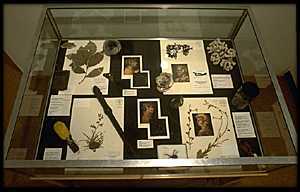 View larger image for description of contents |
Collections such as those of the curiosity cabinet can be ordered in many ways, each way structured with a group of headings encompassing the full spectrum of natural and human phenomena. One way to divide up the world and its objects is into the four seasons of the year. As a cycle, the seasons both encompass the entire sphere of human and natural activities - in effect, circumscribing the cosmos - and indicate that repetition is a quality of time as well as of form and substance. Metaphorically, the cycle of seasons leads from birth to death and then on to regeneration. Here, too, a human life can be seen as a microcosm of the natural world.
Another means of organizing the world, common in the sixteenth-century, is through the four elements (earth, air, fire and water), once believed to compose all the things of the world including human nature. In the sixteenth-century, all natural and man-made objects could be associated with these elements. The connection could be very direct or very obscure. Sometimes myths were the source of the connection; sometimes it was the object's appearance or function.

